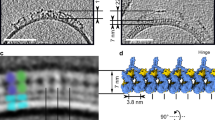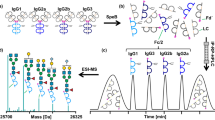Abstract
Four IgG isotypes (IgG1, IgG2a, IgG2b, IgG3) have been distinguished in the mouse1–3. The similarity of the physico-chemical properties of the different isotypes has to a large extent prevented their purification from serum and this has complicated functional studies on IgG antibodies in sera from infected or immunised mice1,2,4. The availability of immunoglobulin-secreting plasmacytomas5, however, has made the production of isotype-specific antisera possible; the use of these antisera has shown immunoglobulin of each isotype to exist in sera from normal animals3,5,6. IgG1 antibodies, partially separated from IgG2 by electrophoresis in agar, have been reported2 to be incapable of sensitising sheep red blood cells (SRBC), passively coated with antigen, for lysis by complement (C) although the antibodies agglutinated the cells and also mediated passive cutaneous anaphylactic (PCA) reactions in the mouse. The IgG2 antibodies, which mediated PCA reactions in the guinea pig but not in the mouse, lysed the antigen-coated SRBC in the presence of mouse C. It seems on the basis of this single report that mouse IgG1 has been widely accepted6–8 to be a ‘non-C-fixing’ class of immunoglobulin—one which, on association with antigen, is unable to activate C. We have now purified IgG1 from the serum of mice immunised with SRBC and in this report present evidence that the IgG1 antibodies are not only haemolytic in the presence of C, but that they apparently account for more than half of the SRBC-specific, C-fixing IgG antibodies in the serum of the immunised animals.
This is a preview of subscription content, access via your institution
Access options
Subscribe to this journal
Receive 51 print issues and online access
$199.00 per year
only $3.90 per issue
Buy this article
- Purchase on SpringerLink
- Instant access to full article PDF
Prices may be subject to local taxes which are calculated during checkout
Similar content being viewed by others
References
Fahey, J.L., Wunderlich, J. & Mishell, R. J. exp. Med. 120, 223–240, 243–251 (1964).
Nussenzweig, R. S., Merryman, C. & Benacerraf, B. J. exp. Med. 120, 315–328 (1964).
Grey, H. M., Hirst, J. W. & Conn, M. J. exp. Med. 133, 289–304 (1971).
Dissanayake, S. & Hay, F. C. Immunochemistry 12, 101–103 (1975).
Potter, M. Physiol. Rev. 52, 631–719 (1972).
Nisonoff, A., Hopper, J. E. & Spring, S. B. The Antibody Molecule, 333–337 (Academic, New York, 1975).
Ovary, Z. Ann. N.Y. Acad. Sci. 129, 776–787 (1966).
Spiegelberg, H. L. Adv. Immun. 19, 259–294 (1974).
Ey, P.L., Prowse, S.J. & Jenkin, C. R. Immunochemistry 15, 429–436 (1978).
Watanabe, N. & Ovary, Z. J. immun. Meth. 14, 381–390 (1977).
Fairbanks, G., Steck, T.L. & Wallach, D. F. H. Biochemistry 10, 2606–2617 (1971).
Fine, D.P., Marney, S.R. Jr, Colley, D.G., Sergent, J.S. & des Prez, R.M. J. Immun. 109, 807–809 (1972).
Ey, P.L., Russell-Jones, G. & Jenkin, C. R. Molec. Immun. (submitted).
Ey, P.L., Prowse, S.J. & Jenkin, C. R. Molec. Immun. (submitted).
Stanislawski, M. & Mitard, M. Immunochemistry 13, 979–984 (1976).
Herzenberg, L.A. & Herzenberg, L.A. in Handbook of Experimental Immunology 2nd edn (ed. Weir, D. M.) Ch. 13 (Blackwell, Oxford, 1973).
Rother, U., Hänsch, G. & Rother, K. Z. Immun.-Forsch. 151, 442–454 (1976).
Hoffman, L. G. & Mayer, M. M. in Methods in Immunology and Immunochemistry Vol. IV, (eds Williams, C. A. & Chase, M. W.) 137–166 (1977).
Author information
Authors and Affiliations
Rights and permissions
About this article
Cite this article
Ey, P., Prowse, S. & Jenkin, C. Complement-fixing IgG1 constitutes a new subclass of mouse IgG. Nature 281, 492–493 (1979). https://doi.org/10.1038/281492a0
Received:
Accepted:
Issue date:
DOI: https://doi.org/10.1038/281492a0
This article is cited by
-
The Beneficial Clinical Effects of Teriflunomide in Experimental Autoimmune Myasthenia Gravis and the Investigation of the Possible Immunological Mechanisms
Cellular and Molecular Neurobiology (2023)
-
Mechanisms involved in antibody- and complement-mediated allograft rejection
Immunologic Research (2010)
-
Construction of chimeric immunogens: Bioactive fragment of human IL-1β or polytuftsin (PT) capable of eliciting immune responses to HIV peptides
Indian Journal of Clinical Biochemistry (1998)
-
Analysis of functional epitopes on the dengue 2 envelope (E) protein using monoclonal IgM antibodies
Archives of Virology (1995)
-
Application of a solid-phase immunofluorometric assay to the selection of monoclonal antibody specific for the adenovirus group-reactive hexon antigen
Archives of Virology (1984)



